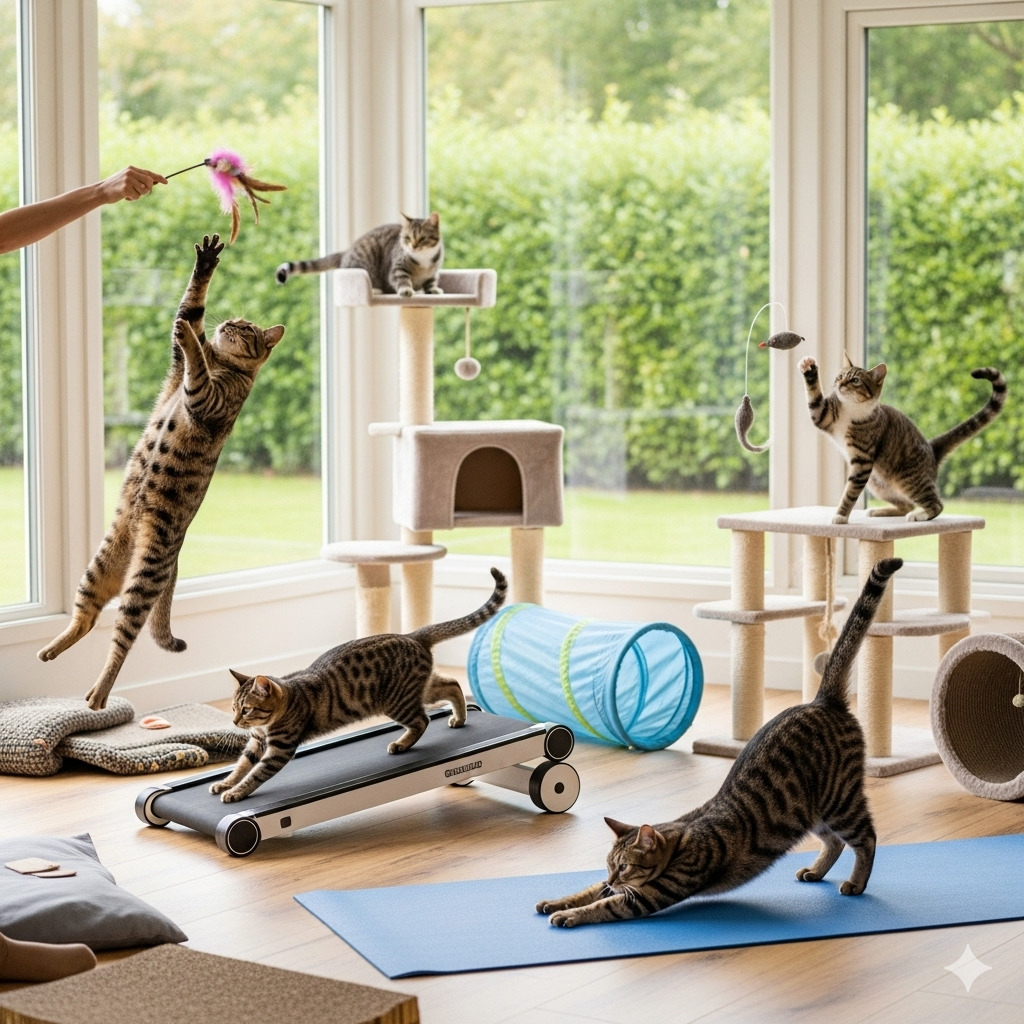“Proven Tips to Keep Your Indoor Cat Active, Healthy, and Happy Every Day”
Indoor cats live safer, longer lives than outdoor cats because they are protected from predators, cars, parasites, and diseases. However, a major challenge arises: lack of exercise and stimulation. Indoor cats can become overweight, bored, or stressed if their physical and mental needs aren’t met.
That’s why cat owners need to create opportunities for daily activity. From interactive toys and climbing furniture to structured play sessions, there are countless ways to ensure your indoor cat stays physically fit, mentally sharp, and emotionally content.
How to Exercise Indoor Cats effectively is essential for keeping them healthy, active, and happy. Indoor cats often miss out on outdoor adventures, so providing proper activities helps prevent boredom, obesity, and stress. Simple routines like interactive toys, climbing trees, laser pointers, and daily play sessions can make a big difference in your cat’s overall well-being. Learn the best tips and techniques to keep your feline friend engaged and energetic, even within limited indoor spaces. Discover safe, fun, and creative ways to give your cat the exercise it needs every day for a healthier, longer life.
Discover More: “Ultimate Cat Care Guide: Tips for Healthy, Happy Cats”

Learn More: “Kitten Care Guide: How to Raise a Healthy Happy Kitten”
Why Indoor Cats Need Exercise?
1. Preventing Obesity
Indoor cats often eat the same amount of food as outdoor cats but burn fewer calories. Lack of activity leads to weight gain, which can cause:
- Diabetes
- Joint problems
- Heart disease
- Shortened lifespan
👉 According to the Association for Pet Obesity Prevention, over 60% of cats in the U.S. are overweight or obese—making exercise essential.
2. Reducing Stress & Anxiety
Cats are natural hunters. Without an outlet for stalking, chasing, and pouncing, they may become stressed. Exercise mimics hunting behaviors, reducing anxiety and boredom.
3. Improving Mental Stimulation
Climbing, chasing, and exploring new activities prevent monotony. Mental stimulation is just as important as physical movement for indoor cats.
👉 The Cornell Feline Health Center emphasizes that enrichment and exercise are key for preventing stress-related behavior issues.
4. Strengthening the Human-Cat Bond
Play sessions create trust and emotional closeness. Your cat associates you with fun and fulfillment, leading to a stronger bond.
How Much Exercise Does an Indoor Cat Need?
Veterinarians recommend at least two 15–20 minute play sessions daily for adult cats. Kittens may need more frequent but shorter sessions due to higher energy levels.
👉 The American Society for the Prevention of Cruelty to Animals (ASPCA) suggests giving cats structured playtime to mimic hunting routines.
- Kittens: 3–4 playtimes of 10 minutes each
- Young adults: 2–3 playtimes of 15–20 minutes
- Senior cats: Gentle 10–15 minute sessions twice a day
Best Indoor Cat Exercise Tips
1. Interactive Play Sessions
Use toys that mimic prey, such as feather wands, laser pointers, or toy mice. Move the toy unpredictably to engage your cat’s hunting instincts.
👉 The RSPCA recommends rotating toys frequently to prevent boredom.
2. Cat Trees & Climbing Towers
Cats are natural climbers. Indoor trees and towers give them vertical territory to explore.
Benefits:
- Builds muscles
- Provides scratching posts
- Offers elevated resting spots
Pro Tip: Place the cat tree near a window so your cat can watch birds outside for added stimulation.
3. Puzzle Feeders & Food Games
Turn mealtime into exercise by using puzzle feeders. Instead of eating from a bowl, your cat will have to “work” for food.
👉 The International Cat Care foundation recommends food puzzles as a way to combine nutrition with enrichment.
4. Laser Pointer Games
Laser pointers are excellent for quick bursts of energy. Move the light unpredictably across walls and floors, simulating prey movement.
Safety tip: Always end the game by switching to a real toy your cat can catch to prevent frustration.
5. DIY Cat Toys
You don’t need expensive toys. Household items work wonders:
- Paper bags (cats love hiding and pouncing)
- Cardboard boxes (build obstacle courses)
- Toilet paper rolls stuffed with treats
6. Cat Wheels (Treadmills for Cats)
Cat exercise wheels are large hamster-style wheels for felines. They allow high-energy breeds (like Bengals or Abyssinians) to run indoors.
7. Training with Clickers
Clicker training isn’t just for dogs. Cats can learn tricks like “sit,” “high five,” or even agility routines. This burns energy and sharpens intelligence.
👉 The ASPCA Training Guide provides beginner-friendly clicker training tips.
8. Play Hide & Seek
Hide treats or toys around your home. Your cat will enjoy the hunting process.
9. Cat TV & Digital Enrichment
Some cats love watching videos of birds, squirrels, or fish. Combine this with toys to encourage pouncing when they see movement.
10. Harness Training for Indoor Cats
With patience, some indoor cats can be leash-trained. Walking your cat outdoors in a safe harness provides excellent exercise and adventure.
👉 The Humane Society of the United States offers step-by-step advice for harness training cats.
Creating an Exercise Routine
Consistency keeps cats happy. Try structuring exercise like this:
- Morning: 10–15 minutes of active play (wand toy or laser)
- Afternoon: Puzzle feeder or hide-and-seek game
- Evening: Climbing and chasing activity on cat trees or tunnels
- Night: Calming play before bed to burn off energy
Breed-Specific Exercise Needs
- High-Energy Breeds (Bengals, Abyssinians, Siamese): Need multiple active sessions daily and benefit from cat wheels.
- Moderate Energy (American Shorthair, Maine Coon): Enjoy climbing structures, puzzle feeders, and interactive toys.
- Low Energy (Persian, Ragdoll, British Shorthair): Prefer gentle play, laser pointers, and short bursts of exercise.
Keeping Senior Cats Active
Older cats still need activity but at a gentler pace. Focus on:
- Wand toys at lower speeds
- Easy climbing shelves with ramps
- Soft play mats for joint protection
- Food puzzles to keep their minds sharp
👉 The PetMD Senior Cat Guide explains how to adapt play for aging cats.
Signs Your Indoor Cat Needs More Exercise
- Weight gain or obesity
- Destructive behaviors (scratching furniture, knocking things over)
- Restlessness at night
- Over-grooming from stress
- Aggression or mood swings
Mistakes to Avoid
- Overusing laser pointers without reward – leads to frustration.
- Same toy every day – cats get bored quickly.
- Pushing too hard – stop if your cat looks tired.
- Ignoring mental enrichment – exercise isn’t just physical.
Health Benefits of Indoor Cat Exercise
- Stronger muscles and bones
- Healthy digestion
- Reduced obesity risk
- Lower anxiety and stress
- Better sleep cycles
- Increased life expectancy
Conclusion
Exercising an indoor cat is about creativity, routine, and bonding. With interactive toys, climbing structures, puzzle feeders, and daily play sessions, you can keep your cat fit and happy. Every cat—whether young or senior—thrives when given the chance to express natural hunting and exploring instincts indoors.
By following these indoor cat exercise tips, you ensure your feline lives a healthier, longer, and more fulfilling life.
